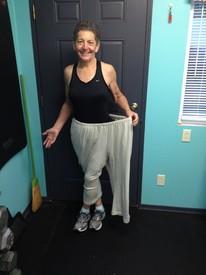Low vitamin D -- any suggestions?
Replies
-
I always supplement, otherwise my lab values are too low. It's not the time of year here for getting it from the sun. I originally took it to help with mood, but it does other things for you, too.0
-
I used to be low...around 20. My doctor had me start with 5,000iu of D3. I live in New Mexico and cycle outdoors regularly and get plenty of sunshine...I'm still deficient without supplementing. With supplementation my numbers are in the normal range.
Getting my numbers up has resulted in a whole host of benefits...I'm sick less often and while I have some anxiety issues from time to time, they have gotten a lot better. Also, it has helped in controlling my hypertension though I still require medications for that.
Keep in mind that vitamin d is fat soluble so you need to consume dietary fat for absorption. I take mine in the morning when I'm eating my eggs.0 -
I was feeling really rough for quite some time.
Had 3 rounds of bloods. The 3rd one showed Vit D at 14 nmol/L (75-200).
GP prescribed me 10,000iu twice a week for 10 weeks. I also take magnesium and K2 plus an extra 2000iu of D on the days i don't take the high amounts. After 3 weeks i started feeling more human again.
0 -
Depending on where a person lives. Folks in Southern California, Arizona, Alabama Georgia , and Florida are in good positions.ValerieMartini2Olives wrote: »Sit in the sun
And depending on their dermatologist. Mine says "no" to my going outside without being covered up with a hat and long sleeves.
0 -
kshama2001 wrote: »The cheap Vit D added to milk is poorly absorbed by most although I would be happy if someone had better info to share.
Fatty fish like salmon, sardines, tuna are a good sources of Vit D as far as I know.
My doc has me on D3 but I don't remember to take it. This thread reminds me. Thanks
Apparently you can check your milk to see if it is fortified with the cheap, less effective D2 or the better D3.
http://www.ncbi.nlm.nih.gov/pubmed/21735411
http://press.endocrine.org/doi/abs/10.1210/jc.2010-2230
http://blog.vitamindcouncil.org/2011/11/16/meta-analysis-looks-at-efficacy-of-d2-vs-d3/
Many people write me and ask, “My doctor prescribed Drisdol, is that OK?” Drisdol is D2 and the form of vitamin D that doctors write prescriptions for. The body doesn’t produce vitamin D2 in response to sun exposure. It is made by irradiating fungus and plant matter. When you take it, a number of metabolic forms of D2 are found in the body, and some studies show D3 (produced by the skin) is more potent, meaning it is more effective at raising blood levels than D2, while some show they are equal. However, there are few studies comparing the efficacy of D2 vs. D3. Or in other words, which form has better health outcomes, better mortality rates?
Recently, a review and meta-analysis address this question. The meta-analysis study was led by Professor Dr. Goran Bjelakovic.
Bjelakovic G, Gluud LL, Nikolova D, Whitfield K, Wetterslev J, Simonetti RG, Bjelakovic M, Gluud C. Cochrane Database Syst Rev. 2011 Jul 6;(7):CD007470.
He analyzed 50 randomized controlled trials (RCTs) with a total of 94,000 participants that used some form of vitamin D and reported mortality rates as either primary or secondary outcomes. Within these RCTs, 32 of the studies used D3 (74,000 subjects) and 12 of them used D2 (18,000 subjects). He found there was a 6% relative risk reduction when supplementing with vitamin D3, as opposed to a 2% relative risk increase when supplementing with vitamin D2
Amazingly, this study somehow slipped under the radar and neither the press nor I picked up this study in July. Luckily, Professor Dr. Harvey Murff of Vanderbilt University reviewed this study yesterday in the Annals of Internal Medicine recently, allowing the general public to examine the study once again.
Murff HJ. Review: Cholecalciferol (vitamin D3) reduces mortality in adults; other forms of vitamin D do not. Ann Intern Med. 2011; 155:JC5-04.
You would think a paper that took a look at tens of thousands of subjects and analyzed the efficacy of prescription vitamin D (D2) and over-the-counter vitamin D (D3) would warrant a news story or two. To my knowledge, these papers are the first to paint such a clear picture about the efficacy between D3 and D2. While there may be explanations for D3’s superiority other than improved efficacy, for the time being, these papers send doctors a message: use D3, not D2.
Thank you for the information on Cholecalciferol (vitamin D3). 0
0 -
milocamolly wrote: »Sunshine! My levels were at 21 last week so I'm taking supplements and getting out in the sun as much as I can. I hope I feel a difference soon because I am always so tired. I need more energy.
Most adults are still vitamin d deficient even with ample sun exposure.0 -
What is Vitamin D use for anyway I hear immune, bone health, and fat loss? Is this true?0
-
Vitamin D supplementation is poorly supported by the research, except in people with very low measured levels (OP wouldn't be in that category). There is an awful lot of woo-woo around this supplement...
Glad you're leading the charge on this instead of me. Hope your armor is sufficient for the inevitable firestorm.
Godspeed, true and noble warrior. Godspeed.0 -
Wait, March!!!
DAGNABBIT! Who tricked me into a zombie thread?!?0 -
Vitamin D supplements and a happy light.0
-
I don't remember my lab numbers, but dr said Vit D was low. Put me on 50,000 IU per week for several weeks, then 2,000 IU per day which I've maintained for years. Yes, it definitely helped.0
-
My husband was D deficient last year. Our Doctor put him on prescription D, I believe I can't remember the exact dosage, but prescription strength is high and taken once a week.
His vitamin D deficiency prompted me to do a lot of research and I found that a good majority of cancers, heart disease and even diabetes are all results of vitamin D deficiency. Our PCP, Dr. Pho, wrote a book called "Health and Vitality Truths:To know and Tell". In the book he described reversing a diabetes diagnosis of one of his patients by vitamin D therapy. 45%-75% of the population are deficient, most do not even know it.
My husband is no longer on prescription strength vitamin D, but he now takes 5,000iu daily on Doctor recommendations. I order Throne, a very reputable brand, from Amazon. Like most people these days, my husband works indoors and just doesn't get enough sunlight. I make him go on outdoor walks with me as often as his time permits. After reading about the possible association of alcohol consumption and low vitamin D, I also made him quit drinking as much and take milk thistle for liver health.
Get online and read about vitamin D deficiency and all the diseases and cancers associated with the deficiency, it will terrify you, or it did me anyway.0 -
I forgot to add, make sure your taking a daily good quality fish oil.
If you take no other supplements, vitamin D, fish oil and a probiotic are the most important to take!0 -
pollypocket1021 wrote: »milocamolly wrote: »Sunshine! My levels were at 21 last week so I'm taking supplements and getting out in the sun as much as I can. I hope I feel a difference soon because I am always so tired. I need more energy.
Most adults are still vitamin d deficient even with ample sun exposure.
Why's that?0 -
pollypocket1021 wrote: »milocamolly wrote: »Sunshine! My levels were at 21 last week so I'm taking supplements and getting out in the sun as much as I can. I hope I feel a difference soon because I am always so tired. I need more energy.
Most adults are still vitamin d deficient even with ample sun exposure.
Why's that?
Sunscreen ?0 -
This content has been removed.
-
pollypocket1021 wrote: »milocamolly wrote: »Sunshine! My levels were at 21 last week so I'm taking supplements and getting out in the sun as much as I can. I hope I feel a difference soon because I am always so tired. I need more energy.
Most adults are still vitamin d deficient even with ample sun exposure.
Why's that?
Sunscreen ?
Maybe… I don't know, the only people I know who are truly diligent with sunscreen are people of Irish descent who have felt the pain of sunburn pretty directly, multiple times.0 -
pollypocket1021 wrote: »milocamolly wrote: »Sunshine! My levels were at 21 last week so I'm taking supplements and getting out in the sun as much as I can. I hope I feel a difference soon because I am always so tired. I need more energy.
Most adults are still vitamin d deficient even with ample sun exposure.
Why's that?
Sunscreen ?
Maybe… I don't know, the only people I know who are truly diligent with sunscreen are people of Irish descent who have felt the pain of sunburn pretty directly, multiple times.
I cannot use sunscreen but I cover up with hats and long sleeves.
0 -
pollypocket1021 wrote: »milocamolly wrote: »Sunshine! My levels were at 21 last week so I'm taking supplements and getting out in the sun as much as I can. I hope I feel a difference soon because I am always so tired. I need more energy.
Most adults are still vitamin d deficient even with ample sun exposure.
Why's that?
Sunscreen ?
Maybe… I don't know, the only people I know who are truly diligent with sunscreen are people of Irish descent who have felt the pain of sunburn pretty directly, multiple times.
I cannot use sunscreen but I cover up with hats and long sleeves.
That's supposed to be the best, in any case, I understand! Certainly for the body.
But for the face - is it the same for you with zinc sunscreens? I usually react very strongly to chemical ones, but this (zinc) one, by derma e, is actually ok for me - it's non-nano, too, and not at all greasy. I never react to it, and that's saying something.
Another thing I know some people who can't wear SS do is wear antioxidant serums as sunscreen, instead:
http://beautyeditor.ca/2011/06/29/just-when-you-thought-sunscreen-was-enough-you-actually-need-this-too-and-seriously-in-10-years-your-skin-will-thank-you
http://www.dermtv.com/antioxidants-become-sunscreen-when-used-during-day
It's not a sunscreen and can't offer the same protection, but it does offer some minimal help that might be ok with a hat (Like I wouldn't rely on just the serum alone, without a hat.)
(Like I wouldn't rely on just the serum alone, without a hat.)
(Worth noting, for the zinc SS: this one does ok at "blending", for a zinc ss, but it does still have a whitish cast, so it really only does that on very pale skin. I haven't seen a zinc SS designed for people who aren't quite white. A way for people with skin that is darker than that to wear it might be to tint it with loose mineral makeup powder. I think that might involve a bit of experimentation, because the result might tend to greyish with colours that don't have quite a deep and probably red or orange base ) 0
) 0 -
pollypocket1021 wrote: »milocamolly wrote: »Sunshine! My levels were at 21 last week so I'm taking supplements and getting out in the sun as much as I can. I hope I feel a difference soon because I am always so tired. I need more energy.
Most adults are still vitamin d deficient even with ample sun exposure.
Why's that?
I think anything north of a certain latitude (I think anything north of Pittsburgh-ish), there is not enough sunlight during the winter months to synthesize enough vitamin D to meet the RDA (even if you're out all day). I remember my nutrition professor saying something about it during a lecture, but I don't remember what she exactly said.0 -
pollypocket1021 wrote: »milocamolly wrote: »Sunshine! My levels were at 21 last week so I'm taking supplements and getting out in the sun as much as I can. I hope I feel a difference soon because I am always so tired. I need more energy.
Most adults are still vitamin d deficient even with ample sun exposure.
Why's that?
I think anything north of a certain latitude (I think anything north of Pittsburgh-ish), there is not enough sunlight during the winter months to synthesize enough vitamin D to meet the RDA (even if you're out all day). I remember my nutrition professor saying something about it during a lecture, but I don't remember what she exactly said.
Yeah, that makes sense, but I thought @pollypocket1021 was saying that adults' vitamin D synthesis is worse than kids', no matter how much sun we get.
(going back a bit - the solution my derm proposed for the sun protection vs. Vit D conundrum in summer is to expose my arms and legs for 20 minutes a day but keep my face protected)0 -
pollypocket1021 wrote: »milocamolly wrote: »Sunshine! My levels were at 21 last week so I'm taking supplements and getting out in the sun as much as I can. I hope I feel a difference soon because I am always so tired. I need more energy.
Most adults are still vitamin d deficient even with ample sun exposure.
Why's that?
I think anything north of a certain latitude (I think anything north of Pittsburgh-ish), there is not enough sunlight during the winter months to synthesize enough vitamin D to meet the RDA (even if you're out all day). I remember my nutrition professor saying something about it during a lecture, but I don't remember what she exactly said.
Yeah, that makes sense, but I thought @pollypocket1021 was saying that adults' vitamin D synthesis is worse than kids', no matter how much sun we get.
(going back a bit - the solution my derm proposed for the sun protection vs. Vit D conundrum in summer is to expose my arms and legs for 20 minutes a day but keep my face protected)
The kids>adults thing is something that I've heard speculated but I have not seen observational studies that compare the two.
The hypothesis is that innate vitamin d synthesis decreases with age, like with other hormones. But most of the data I have personally seen relates to adults and at risk kids. It does not compare baseline values across healthy populations at various ages.
Adults in Florida who sunbathe daily are likely to be vitamin d deficient if they do not supplement.0 -
@Optimistical1 Hello=-) does your husband check his blood levels regularly? I'm curious if his 5,000iu is maintaining the correct level? Do you aim for a standard blood level, or does your PCP recommend a higher level? Thanks=-)0
-
pollypocket1021 wrote: »pollypocket1021 wrote: »milocamolly wrote: »Sunshine! My levels were at 21 last week so I'm taking supplements and getting out in the sun as much as I can. I hope I feel a difference soon because I am always so tired. I need more energy.
Most adults are still vitamin d deficient even with ample sun exposure.
Why's that?
I think anything north of a certain latitude (I think anything north of Pittsburgh-ish), there is not enough sunlight during the winter months to synthesize enough vitamin D to meet the RDA (even if you're out all day). I remember my nutrition professor saying something about it during a lecture, but I don't remember what she exactly said.
Yeah, that makes sense, but I thought @pollypocket1021 was saying that adults' vitamin D synthesis is worse than kids', no matter how much sun we get.
(going back a bit - the solution my derm proposed for the sun protection vs. Vit D conundrum in summer is to expose my arms and legs for 20 minutes a day but keep my face protected)
The kids>adults thing is something that I've heard speculated but I have not seen observational studies that compare the two.
The hypothesis is that innate vitamin d synthesis decreases with age, like with other hormones. But most of the data I have personally seen relates to adults and at risk kids. It does not compare baseline values across healthy populations at various ages.
Adults in Florida who sunbathe daily are likely to be vitamin d deficient if they do not supplement.
Ah yeah, that makes sense. Thanks!0
This discussion has been closed.
Categories
- All Categories
- 1.4M Health, Wellness and Goals
- 398.5K Introduce Yourself
- 44.7K Getting Started
- 261K Health and Weight Loss
- 176.4K Food and Nutrition
- 47.7K Recipes
- 233K Fitness and Exercise
- 462 Sleep, Mindfulness and Overall Wellness
- 6.5K Goal: Maintaining Weight
- 8.7K Goal: Gaining Weight and Body Building
- 153.5K Motivation and Support
- 8.4K Challenges
- 1.4K Debate Club
- 96.5K Chit-Chat
- 2.6K Fun and Games
- 4.8K MyFitnessPal Information
- 18 News and Announcements
- 21 MyFitnessPal Academy
- 1.5K Feature Suggestions and Ideas
- 3.2K MyFitnessPal Tech Support Questions













